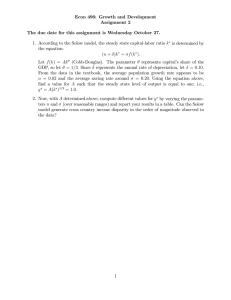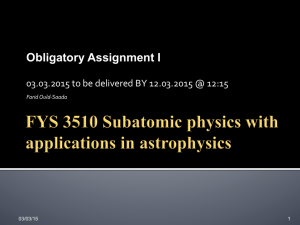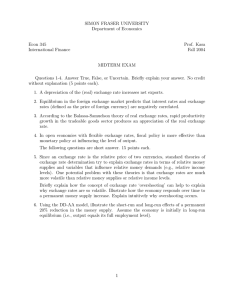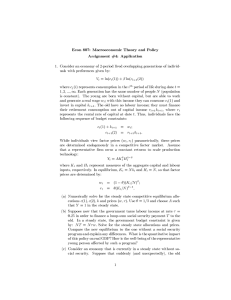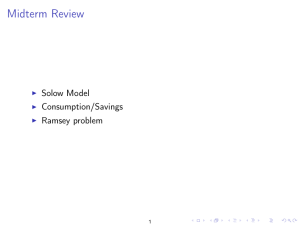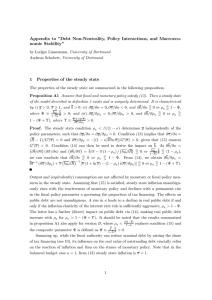SIMON FRASER UNIVERSITY Department of Economics Econ 808 Prof. Kasa
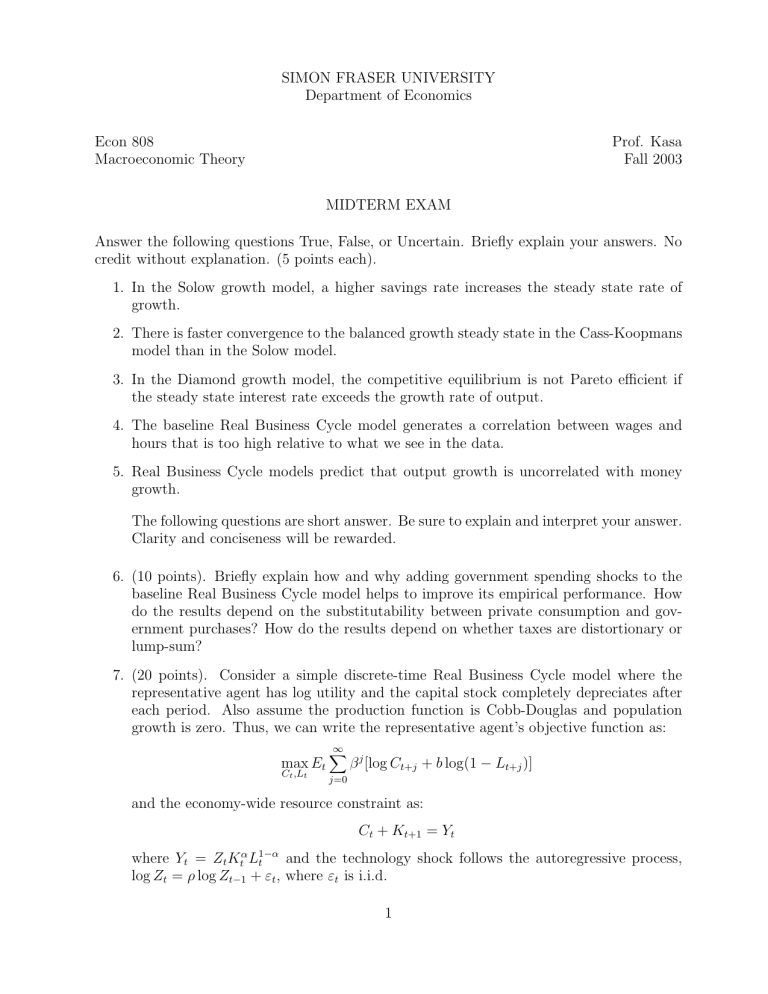
SIMON FRASER UNIVERSITY
Department of Economics
Econ 808
Macroeconomic Theory
Prof. Kasa
Fall 2003
MIDTERM EXAM
Answer the following questions True, False, or Uncertain. Briefly explain your answers. No credit without explanation. (5 points each).
1. In the Solow growth model, a higher savings rate increases the steady state rate of growth.
2. There is faster convergence to the balanced growth steady state in the Cass-Koopmans model than in the Solow model.
3. In the Diamond growth model, the competitive equilibrium is not Pareto efficient if the steady state interest rate exceeds the growth rate of output.
4. The baseline Real Business Cycle model generates a correlation between wages and hours that is too high relative to what we see in the data.
5. Real Business Cycle models predict that output growth is uncorrelated with money growth.
The following questions are short answer. Be sure to explain and interpret your answer.
Clarity and conciseness will be rewarded.
6. (10 points). Briefly explain how and why adding government spending shocks to the baseline Real Business Cycle model helps to improve its empirical performance. How do the results depend on the substitutability between private consumption and government purchases? How do the results depend on whether taxes are distortionary or lump-sum?
7. (20 points). Consider a simple discrete-time Real Business Cycle model where the representative agent has log utility and the capital stock completely depreciates after each period. Also assume the production function is Cobb-Douglas and population growth is zero. Thus, we can write the representative agent’s objective function as:
∞ max
C t
,L t
E t j =0
β j
[log C t + j
+ b log(1
−
L t + j
)] and the economy-wide resource constraint as:
C t
+ K t +1
= Y t where Y t
= Z t
K t
α
L
1 − α and the technology shock follows the autoregressive process, log Z t = ρ log Z t − 1 + ε t , where ε t is i.i.d.
1
(a) Write down the Bellman equation that characterizes the planner’s problem.
(b) Solve for the optimal consumption and labor supply policy functions in terms of the unknown value function.
(c) Guess a log-linear functional form for the value function and solve for the relevant unknown coefficients. (Hint: To get the policy functions you don’t actually have to solve for all of the unknown coefficients).
(d) Substitute the value function coefficients into the policy functions and interpret the resulting decision rules for consumption and labor supply. Are they consistent with observed business cycle facts?
(e) Derive a second-order difference equation characterizing the equilibrium time-series process for output.
8. (25 points). Consider a standard continuous-time Cass-Koopmans model. Preferences of the representative household are given by max c
0
∞ c
1 − θ
1
−
θ e
− ρt dt
Assume that the (per capita) production function takes the Cobb-Douglas form, f ( k ) = k
α
, where k is the capital/labor ratio. Assume capital depreciates at rate δ , population growth, n , is zero, and assume there is no labor-augmenting technological progress (ie, g = 0).
(a) Write down a pair of differential equations that characterize the optimal time paths for c and k .
(b) Graph these equations in a phase diagram. Draw in the saddlepath.
(c) Use the phase diagram to illustrate how the economy responds over time to a sudden (permanent) rise in the discount rate, ρ . Do the same for a sudden loss of part of the economy’s capital stock.
(d) Calculate steady state output, consumption, and the steady state (gross) savings rate (ie, s
∗
= 1
− c
∗
/y
∗
).
(e) Briefly discuss how the optimal time paths for c and k could be decentralized as a competitive equilibrium. What are the equilibrium interest rate and wage rate?
9. (20 points). Consider the same economy as in the previous question, only now assume the production function takes the “AK” form, f ( k ) = Ak .
(a) Under what conditions does this model generate “endogenous growth”?
(b) What are the empirical shortcomings of this kind of model?
(c) Briefly discuss two alternative strategies for generating endogenous growth.
2
